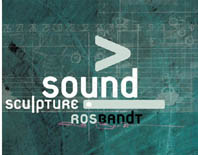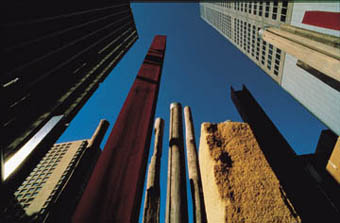Chartering the landscape of time and space
John Potts

Sound scultpure: Intersectionms in Sound and Sculpture in Australian Artworks by Ros Bandt
This book is welcome in many respects. It is welcome as a documentation of Australian sound sculpture, which has been—in Ros Bandt’s words—“an uncharted landscape of time and space.” It is very welcome for its lavish production, including some excellent photography, colour reproduction of artists’ scores and charts, and a 30 track CD coordinated with the text. It is also most welcome for the comprehensive account of artworks and artists provided by Bandt, who is herself prominent in the field.
As she remarks, the ephemeral nature of sound—and of most installation-based work—makes sound-oriented art difficult “to design, capture and document.” The book is a major step forward in the documentation process. Significant works by Nigel Helyer, Joan Brassil, Joyce Hinterding and many other artists are displayed, described, and represented on the CD. By combining audio excerpts with photos and illustrations, this book comes as close as a book can to document such multi-faceted work.
The range of artists covered is extensive. No doubt some readers will point to omissions, but that is inevitable in a book of this type. More important is that Ros Bandt has assembled a broad range of works here, and the book’s designer has presented them in an engaging format. The curious reader will be drawn in by the attractive design (some of the photos are superb), and to accommodate those unfamiliar with the field, the book includes a glossary, discography and bibliography.
For all its impressive qualities, this book would have been lifted into a higher league by a stronger conceptual account of the field. Consider the opening sentence: “Sound sculpture has been as ubiquitous as it is varied and ephemeral.” This confusing effort is a bad sentence anywhere, but as the opening of the book it doesn’t augur well. The problem with Bandt’s text, however, goes beyond sentence structure. It relates to the slight theoretical approach she takes to sound sculpture, which is nowhere adequately conceptualised as a form with its own specific attributes, criteria and history. The curious reader is likely to come away impressed by certain works, but confused by the incoherent account provided of sound sculpture.
Partly this problem derives from Ros Bandt’s rejection of recent sound-art theory, which for her “has borrowed heavily from other fashionable post-modern disciplines.” She complains that this theoretical work (well developed by Australian writers) lacks attention to specific art works, due to its dependence on “European linguistic and philosophical texts.” This is fair enough up to a point: at least here we’ll be spared the ordeal of theorists struggling to fit Derrida—with his literary bias—into the non-literary domain of sound. But for her book to succeed, she needed to replace this body of sound theory with something cogent.
Her (laudable) aim is to “present original artworks first”; from examination of these works, her hope is that “a relevant language will emerge in an appropriate way.” Yet the quest for this relevant language is a failed one in Sound Sculpture, mainly because there is no well-defined sense of what sound sculpture is. When generalisations are attempted, they are questionable. “Most sound sculptures,” we are told, “defy categorisation and are their own composite blend of visual and aural characteristics.” The visual/aural intersection or “ricochet” is repeatedly mentioned as the core of sound sculpture—which raises the question: “Is that all?” What of tactility, which is surely part of the sculptural element, and an important sensory factor?
The multi-disciplinary nature of this medium—with its fusion of music, sound, sculpture, electronics, architecture, acoustic engineering, design and other components—is part of the form’s fascination. But Bandt passes over this unique hybridity in a few sentences, preferring to discuss the works according to categories such as “machines and automata” and “indoor installation.” This creates the effect of a rather random detailing of works, with no thematic exposition. Any appreciation of sound sculpture as a specific art form is achieved only incidentally, with no developed idea of problems specific to the form, how artists engage with materials and technology—and no sense of the criteria by which works might be judged. This doesn’t require a canon to be built, or masterworks to be revered, but it does require some suggestion of ways in which the success of a work may be appreciated.
Strangest of all is the absence of a history of the form—or of any kind of context. Sound sculpture seems to have dropped out of the ether. Given that the book mentions work by Percy Grainger from the 1890s and the 1950s, there was the opportunity to sketch some of sound sculpture’s background or to detail the way its myriad components have come together to shape this thing called sound sculpture. Some exposition of this type would have provided the text with much-needed definition.

Janet Laurence and Fiona Foley, The Edge of the Trees, Museum of Sydney J Plaza
As it is, many of the observations are glib and superficial. In discussing Australia as an acoustic environment, Bandt compares “the hustle and bustle of Sydney’s Circular Quay” with “the quiet whispering of the casuarina trees in the remote Lake Mungo region.” Surely some recognition of the differences between urban built environments and natural ones is needed here. Later there is the claim, “Acoustic space is void. Sound fills it.” This peculiar statement—void of what? if the space is acoustic then it isn’t void of sound—shows the text’s need for at least some reference to the sound theory disdained by its author.
To be fair to Ros Bandt, she hasn’t set out to write a definitive theoretical work. She hopes that her book will “lay the foundation for more informed critical debate and discourse” around this topic. But for all this book’s impressive documentation and description, it could have laid a much more substantial foundation for future development.
Sound Sculpture: Intersections in Sound and Sculpture in Australian Artworks, Ros Bandt, Craftsman House, Sydney, 2001.
RealTime issue #49 June-July 2002 pg. 33






